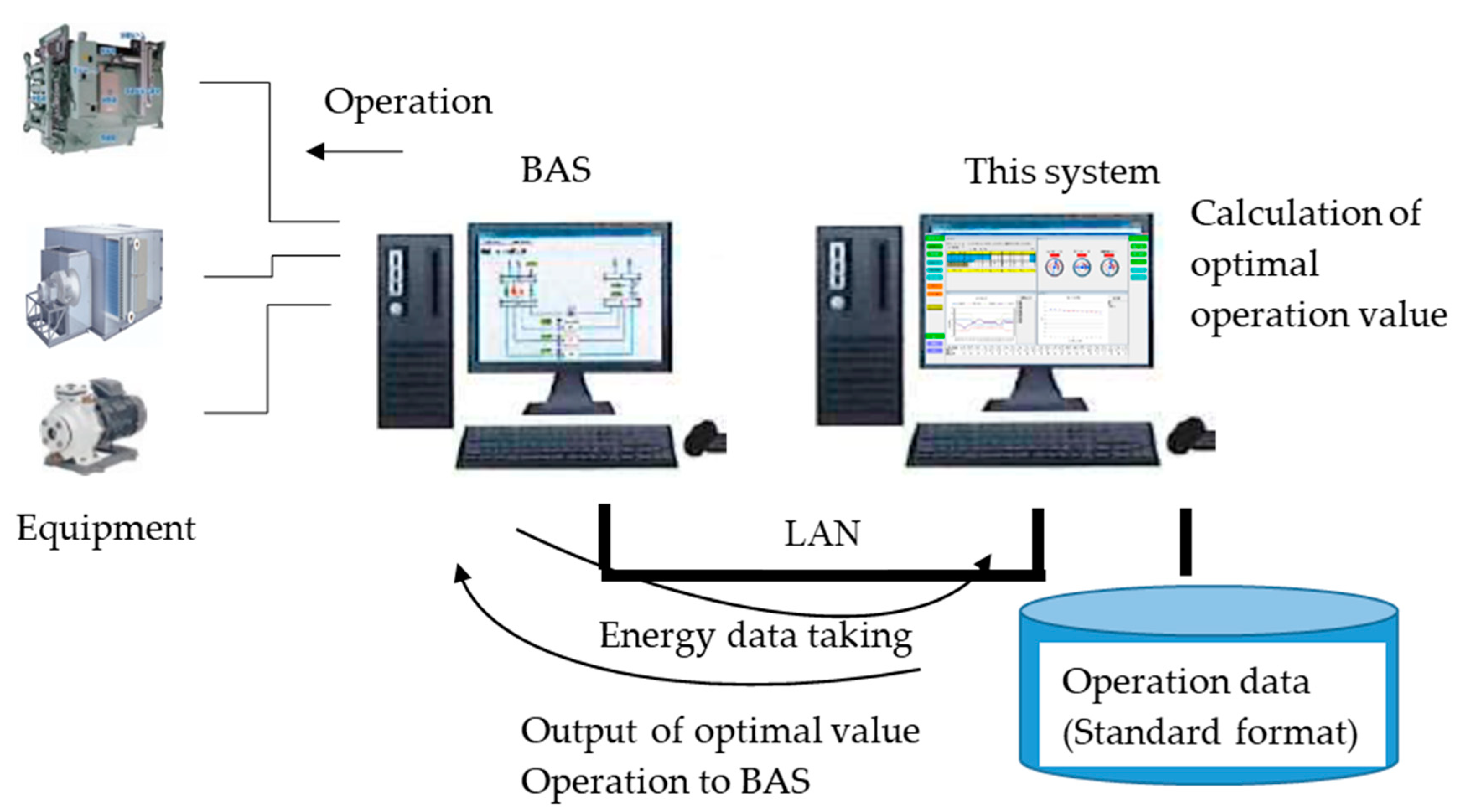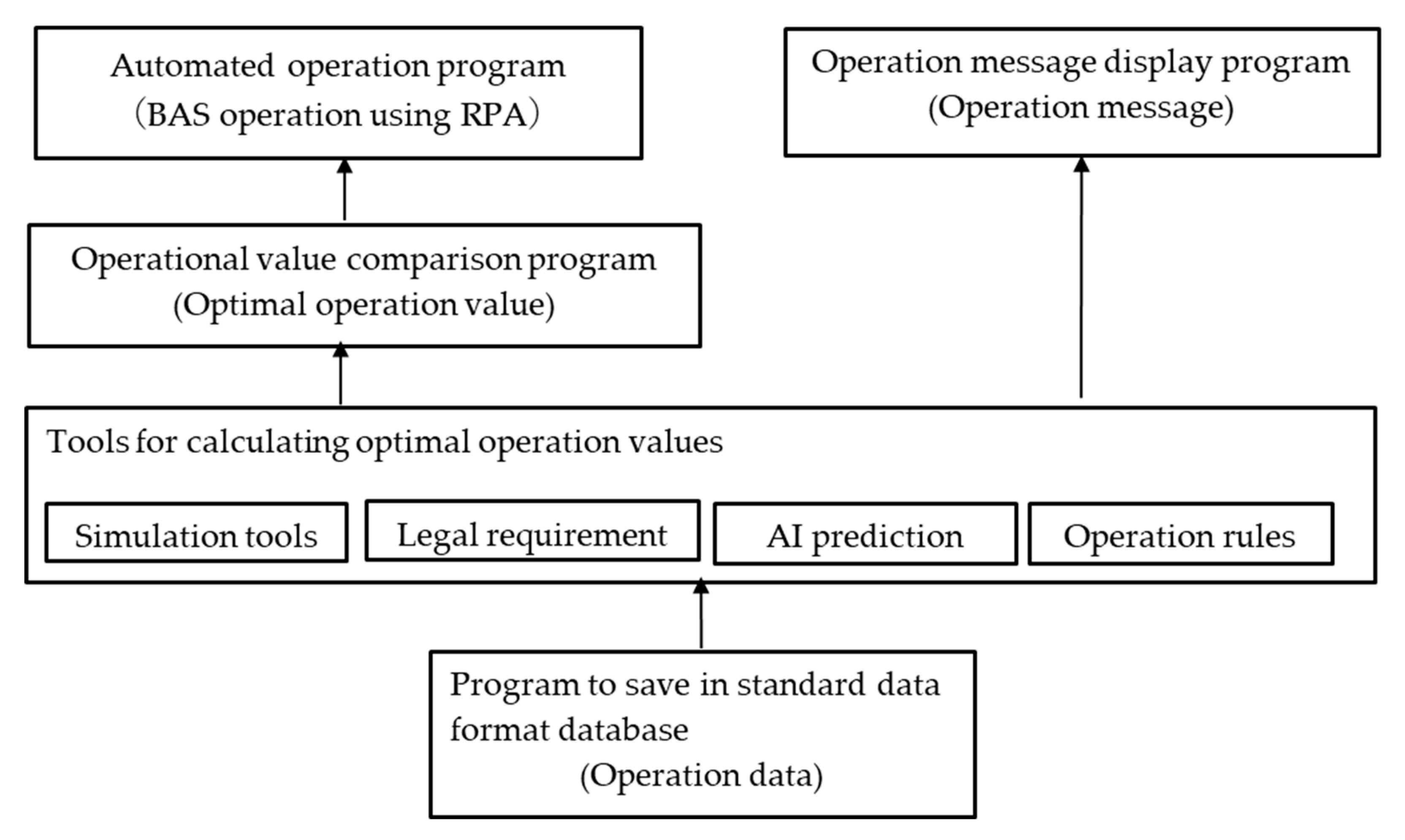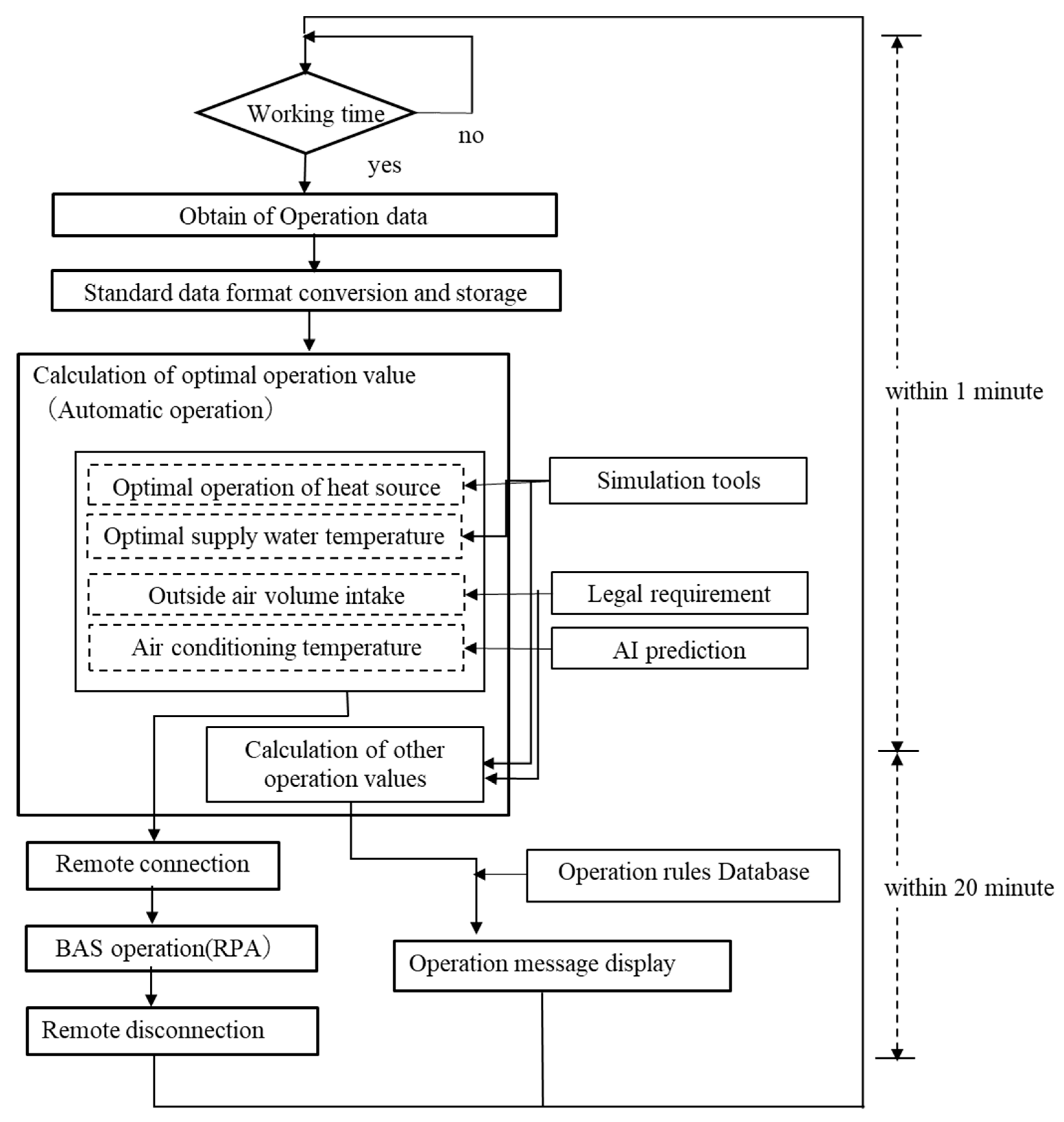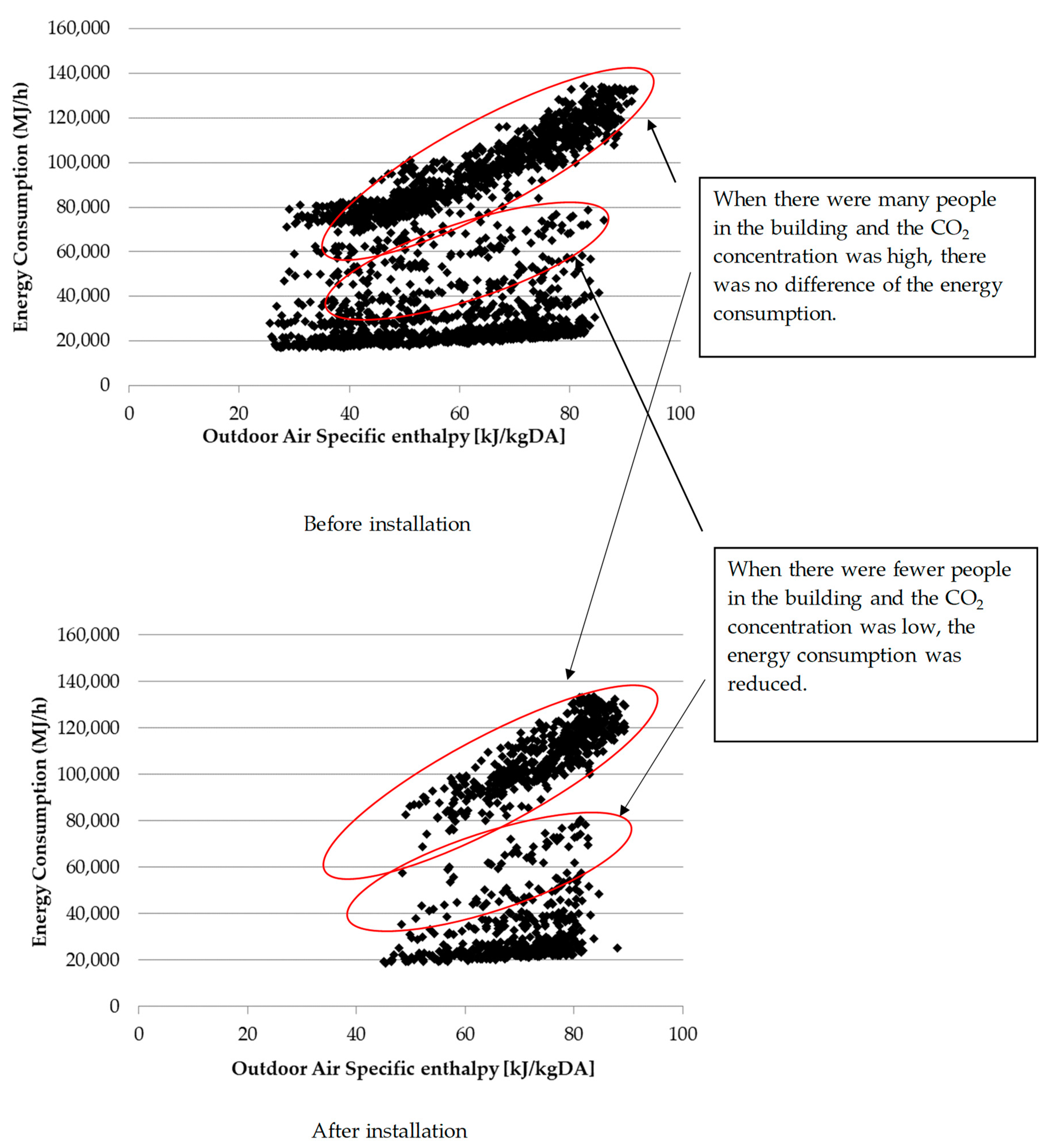Automatic Energy-Saving Operations System Using Robotic Process Automation
Abstract
1. Introduction
2. System Overview
2.1. System Configuration
2.2. Automatic Energy-Saving Operation Items
2.3. System Software Configuration
2.4. Operation Flow
3. Application to Shopping Mall
3.1. Equipment Targeted by Automatic Energy-Saving Operation
- (1)
- If the outside-air dew-point temperature should exceed 20 °CDP, the outside-air processing unit for the entrance will be activated regardless of CO2 concentration to prevent condensation near the entrance.
- (2)
- If the outside-air specific enthalpy should drop below the indoor specific enthalpy during the air conditioning period, the outside-air processing units will be activated regardless of CO2 concentration to perform air conditioning using outside air.
- (3)
- If the outside-air temperature should drop to 5 °C or less, the outside-air processing unit for the entrance will be activated regardless of CO2 concentration to mitigate cold air penetration near the entrance.
3.2. Energy Reduction Evaluation
4. Conclusions
- (1)
- Evaluate energy consumption with respect to the optimal operation of heat source equipment for outside-air processing by performing calculations using hourly simulations [6,7] of the optimal operation method of the heat-source system and by performing start/stop operation of heat source equipment from the central monitoring equipment.
- (2)
- Evaluate energy consumption with respect to heat-source supply water temperature by developing a simulator using a heat transfer coefficient formula for the air conditioning coil and by setting the heat-source supply water temperature hourly from the central monitoring equipment.
- (3)
Author Contributions
Funding
Conflicts of Interest
References
- Pérez-Lombard, L.; Ortiz, J.; Pout, C. A review on buildings energy consumption information. Energy Build. 2008, 40, 394–398. [Google Scholar] [CrossRef]
- General Energy Statistics. Agency for Natural Resources and Energy Home Page. Available online: https://www.enecho.meti.go.jp/statistics/total_energy/results.html#headline2 (accessed on 15 March 2020).
- Ministry of the Environment Government of Japan Home Page. Available online: http://www.env.go.jp/earth/%EF%BD%922050%20Zero%20Carbon%20Cities%20in%20JAPAN.pdf (accessed on 15 March 2020).
- The Energy Conservation Center, Japan Home Page. Available online: https://eco-hint.tokyo-cci.or.jp/practicalguide2/g2-8 (accessed on 15 March 2020).
- The Energy Conservation Center, Japan Home Page. Available online: https://www.meti.go.jp/shingikai/enecho/shoene_shinene/sho_energy/kojo_handan/pdf/2019_003_01_02.pdf (accessed on 15 March 2020).
- Cao, K.; von Krbek, K.; Wetzel, M.; Cebulla, F.; Schreck, S. Classification and Evaluation of Concepts for Improving the Performance of Applied Energy System Optimization Models. Energies 2019, 12, 4656. [Google Scholar] [CrossRef]
- Eisenhower, B.; O’Neill, Z.; Narayanan, S.; Fonoberov, V.A.; Mezic’, I. A methodology for meta-model based optimization in building energy models. Energy Build. 2012, 47, 292–301. [Google Scholar] [CrossRef]
- Automatic Control Device Catalog, Manufacturer Home Page. Available online: https://www.azbil.com/jp/product/building/system/building-automation-system/savic-net-G5/application.html (accessed on 17 April 2020).
- The Energy Conservation Center, Japan Website. Available online: https://www.eccj.or.jp/office_bldg/01.html (accessed on 15 March 2020).
- U.S. Energy Information Administration, Commercial Building Energy Consumption Survey. Available online: https://www.eia.gov/consumption/commercial (accessed on 15 March 2020).
- Rey-Hernández, J.M.; Velasco-Gómez, E.; José-Alonso, S.; Julio, F.; Tejero-González, A.; González-González, S.L.; Rey-Martínez, F.J. Monitoring Data Study of the Performance of Renewable Energy Systems in a Near Zero Energy Building in Spain: A Case Study. Energies 2018, 11, 2979. [Google Scholar] [CrossRef]
- SHASE. The Society of Heating, Air-Conditioning and Sanitary Engineers of Japan, 14th ed.; Hand Book; SHASE: Tokyo, Japan, 2010; pp. 140–142. [Google Scholar]
- Ngrambe, J.; Yun, G.Y.; Santamouris, M. The use of artificial intelligence (AI) methods in the prediction of thermal comfort in buildings: Energy implications of AI-based thermal comfort controls. Energy Build. 2020, 211. [Google Scholar] [CrossRef]
- Zamora-Martínez, F.; Romeu, P.; Botella-Rocamora, P.; Pardo, J. On-line learning of indoor temperature forecasting models towards energy efficiency. Energy Build. 2014, 83, 162–172. [Google Scholar] [CrossRef]
- Yamamoto, T.; Hayama, H.; Hayashi, T. Formulation of Coefficient of Performance Characteristics of Water-cooled Chillers and Evaluation of Composite COP for Combined Chiller. Energies 2020, 13, 1182. [Google Scholar] [CrossRef]
- Taulli, T. The Robotic Process Automation Handbook; Apress: Berkeley, CA, USA, 2020; ISBN 978-1-4842-5728-9. [Google Scholar] [CrossRef]
- Manufacturer Home Page. Available online: https://www.abbyy-flexicapture.com/rpa-ocr/?keyword=robotic%20process%20automation%20software&campaignid=333782971&adgroupid=1285329340281015&Network=o&phone=248-447-0100&msclkid=158a9f59fae41570ae2cc134771a05b1&utm_source=bing&utm_medium=cpc&utm_campaign=ABBYY%20FlexiCapture%20RPA%20Imported%20from%20GA&utm_term=robotic%20process%20automation%20software&utm_content=RPA%20OCRRPA (accessed on 15 March 2020).
- Manufacturer Home Page. Available online: https://www.airslate.com/?msclkid=a839053f41f61d4d3b1a5b52cf3db505&utm_source=bing&utm_medium=cpc&utm_campaign=main-page&utm_term=rpa%20software&utm_content=robotics%20process%20automation (accessed on 15 March 2020).
- Escrivá-Escrivá, G.; Segura-Heras, I.; lAlcázar-Ortega, M. Application of an energy management and control system to assess the potential of different control strategies in HVAC systems. Energy Build. 2010, 42, 2258–2267. [Google Scholar] [CrossRef]
- MicrosoftⓇExcelⓇ2016 MSO 32bit. Available online: https://microsoft-excel-2016.softonic.jp/ (accessed on 17 April 2020).
- Braslavsky, J.H.; Wall, J.R.; Reedman, L.J. Optimal distributed energy resources and the cost of reduced greenhouse gas emissions in a large retail shopping centre. Appl. Energy 2015, 155, 120–130. [Google Scholar] [CrossRef]
- Benchmark Indicators. Agency for Natural Resources and Energy Home Page. Available online: https://www.enecho.meti.go.jp/category/saving_and_new/saving/enterprise/overview/institution/index.html (accessed on 17 April 2020).
- Newsham, G.R.; Xue, H.; Arsenault, C.; Valdes, G.J.; Scarlett, B.E.; Kruithof, S.G.; Shen, W. Testing the accuracy of low-cost data streams for determining single-person office occupancy and their use for energy reduction of building services. Energy Build. 2017, 135, 137–147. [Google Scholar] [CrossRef]







| Management Equipment | Management Items | Data Item | Unit | Sequence Number |
|---|---|---|---|---|
| Absorption chiller | Efficiency | Coefficient of performance | – | 564 |
| Load ratio | Load ratio | – | 565 | |
| Supply water temperature | Supply water temperature | ℃ | 566 | |
| Cooling water temperature | Cooling water inlet temperature | ℃ | 567 | |
| Data for calculating management items | Operating status | – | 568 | |
| Cooling / heating status | – | 569 | ||
| Output energy | MJ/h | 570 | ||
| Energy consumption | m3/h | 571 | ||
| Auxiliary power | kWh | 572 | ||
| Supply water outlet temperature | ℃ | 573 | ||
| Supply water inlet temperature | ℃ | 574 | ||
| Supply water flow rate | m3/h | 575 | ||
| Cooling water outlet temperature | ℃ | 576 | ||
| Excess air ratio | Excess air ratio | – | 577 | |
| Data for calculating management items | Exhaust gas temperature | ℃ | 578 | |
| Residual oxygen concentration | % | 579 |
| Energy Use Category | Energy Consumption Rate (%) | Equipment | Energy-Saving Measures | |
|---|---|---|---|---|
| Update | Optimal Operation | |||
| Air Conditioning | 31.1 | Heat source equipment | Update to high efficiency equipment | Operation of heat source equipment |
| Supply water temperature setting | ||||
| 2.6 | Cooling and heat water pumps | Installation of energy-saving system (speed control device, total heat exchanger, etc.) | Pressure setting | |
| 9.4 | Air handling units | Outside air volume setting | ||
| Room temperature setting | ||||
| Illumination | 21.3 | Lighting equipment | Update to high efficiency equipment (LED luminaire, etc.) | Lighting time setting, Illumination setting |
| Plug | 21.1 | Computers, monitors, etc. | ||
| Hot water supply | 0.8 | Boilers | Update to high efficiency equipment | Steam pressure setting |
| Power system | 3.6 | Elevators, water supply pumps | Operation time setting | |
| 5.0 | Ventilation equipment | Operation time setting | ||
| Other | 5.1 | Transformers, other pumps | – | |
| OHU | Supply Location | Cooling Capacity (kW) | Volume of Outside Air Intake (m3/h) | Supply Fan Capacity (kW) |
|---|---|---|---|---|
| OHU-1F-1 | Product sales store | 210.2 | 17,600 | 7.5 |
| OHU-1F-2 | Food and Product sales store | 162.5 | 13,620 | 7.5 |
| OHU-1F-3 | Product sales store, Common areas | 312.4 | 26,190 | 15.0 |
| OHU-1F-4 | Food and Product sales store | 98.0 | 8220 | 3.7 |
| OHU-1F-5 | Food and Product sales store | 179.1 | 15,010 | 7.5 |
| OHU-1F-6 | Backyard | 179.4 | 15,040 | 7.5 |
| OHU-2F-1 | Home appliance store | 119.3 | 10,000 | 5.5 |
| OHU-2F-2 | Sporting goods store | 117.4 | 9840 | 5.5 |
| OHU-2F-4 | Product sales store, Common areas | 328.7 | 27,560 | 15.0 |
| OHU-2F-5 | Product sales store | 129.6 | 10,860 | 5.5 |
| OHU-2F-6 | Product sales store | 136.7 | 11,460 | 5.5 |
| OHU-2F-7 | Amusement areas | 79.5 | 6660 | 3.7 |
| OHU-2F-8 | Food court areas | 111.7 | 9360 | 3.7 |
| (a) Energy consumption of heat source equipment. | ||||||
| Term | Gas Consumption (GHP) m3 | Electric Consumption (EHP) kWh | ||||
| Before Installation | After Installation | Saving Amount | Before Installation | After Installation | Saving Amount | |
| August | 17,217 | 14,722 | 2495 | 0 | 0 | 0 |
| September | 5098 | 1789 | 3309 | 0 | 0 | 0 |
| October | 1334 | 736 | 598 | 0 | 0 | 0 |
| November | 0 | 0 | 0 | 15,215 | 10,216 | 4999 |
| December | 4 | 34 | −30 | 69,455 | 41,622 | 27,833 |
| January | 59 | 138 | −79 | 136,995 | 54,448 | 82,547 |
| February | 571 | 26 | 545 | 96,004 | 52,711 | 43,293 |
| Total | 24,283 | 17,445 | 6838 | 317,669 | 158,997 | 158,672 |
| (b) Energy consumption of supply fans and total energy consumption. | ||||||
| Term | Electric Consumption (Supply fan) kWh | Total Consumption of Outdoor Air Treatment GJ | ||||
| Before Installation | After Installation | Saving Amount | Before Installation | After Installation | Saving Amount | |
| August | 19,534 | 14,693 | 4841 | 965 | 806 | 160 |
| September | 18,751 | 3294 | 15,457 | 412 | 113 | 300 |
| October | 19,105 | 6731 | 12,373 | 246 | 99 | 148 |
| November | 18,486 | 12,412 | 6074 | 329 | 221 | 108 |
| December | 12,298 | 9591 | 2707 | 798 | 501 | 297 |
| January | 19,087 | 12,243 | 6843 | 1526 | 657 | 869 |
| February | 16,814 | 9220 | 7595 | 1127 | 606 | 521 |
| Total | 124,075 | 68,184 | 55,890 | 5403 | 3002 | 2403 |
© 2020 by the authors. Licensee MDPI, Basel, Switzerland. This article is an open access article distributed under the terms and conditions of the Creative Commons Attribution (CC BY) license (http://creativecommons.org/licenses/by/4.0/).
Share and Cite
Yamamoto, T.; Hayama, H.; Hayashi, T.; Mori, T. Automatic Energy-Saving Operations System Using Robotic Process Automation. Energies 2020, 13, 2342. https://doi.org/10.3390/en13092342
Yamamoto T, Hayama H, Hayashi T, Mori T. Automatic Energy-Saving Operations System Using Robotic Process Automation. Energies. 2020; 13(9):2342. https://doi.org/10.3390/en13092342
Chicago/Turabian StyleYamamoto, Toru, Hirofumi Hayama, Takao Hayashi, and Taro Mori. 2020. "Automatic Energy-Saving Operations System Using Robotic Process Automation" Energies 13, no. 9: 2342. https://doi.org/10.3390/en13092342
APA StyleYamamoto, T., Hayama, H., Hayashi, T., & Mori, T. (2020). Automatic Energy-Saving Operations System Using Robotic Process Automation. Energies, 13(9), 2342. https://doi.org/10.3390/en13092342







